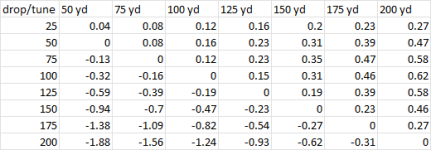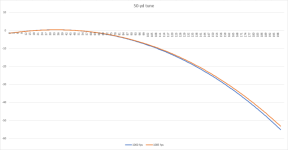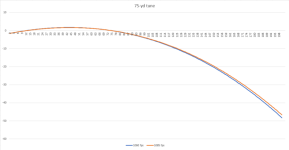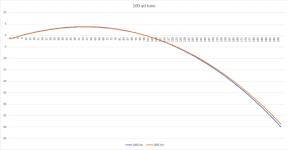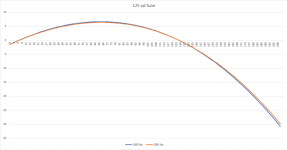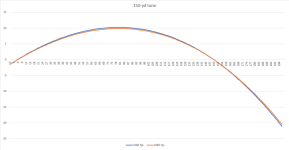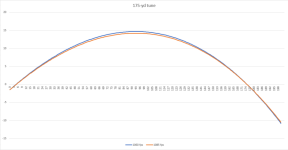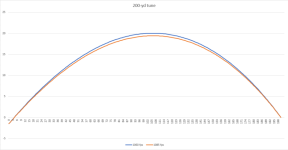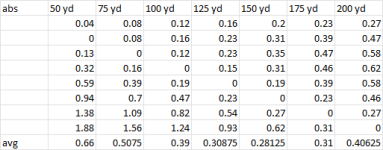Obviously I was talking about in the same rifle. You don't seem to pay attention very well. Sorry, man, but once again basic ballistics dictates that you are incorrect here. It doesn't matter if you have a tuner on the muzzle or not, the physics involved is still the same. The tuner just changes one of the factors. As I've already tried to get you to do many, many times, go test several different ammo at a handful of different distances from the same rifle. You will find exactly what I said you'll find, that they don't all shoot best at the same distance. And the reason is precisely what I've laid out for you several times and had to repeat here again. I'll word it yet another way for you now. Convergence is another word for tuning. When you tune you are changing where convergence happens. And when you are not using a tuner the convergence distance is dictated by the rifle and ammo pairing. Every pairing has the potential to be quite different. I have, on many occasions, over the years done lot testing before a bunch of us all had to buy ammo at the same time. We would all shoot the same handful of lot numbers from our various guns. They all performed a little differently and preferred different lots for different distances. And we didn't all buy the same lot number as a result. Because each rifle/ammo pairing converges at a different distance. That's just how it works, man. You don't even understand what you said in your own post here, because you contradict yourself due to that misunderstanding. "There is a non-linear growth rate in group sizes as distance increases." is literally just another way of saying what I am saying. I don't have enough palms to facepalm with, here, for the amount of whooshing over your head that is happening. Sheesh.In another recent thread it was a key point you insisted was true. This is what you wrote: "I said if you find the distance that a given ammo shoots its best at then you will also find it will shoot worse at every other distance. This is 100% true."
I can understand if you've reconsidered.
Post #6 above offers two explanations, only one of which seems plausible.
The idea that any ammo/rifle/tuner combination performs optimally at one specific distance is correct if positive compensation accurately explains how tuners work.
The idea that with no tuner involved any ammo and rifle will perform optimally at only one distance is not correct. Ammo is not distance-specific. Ammo that shoots very well at 100 will shoot very well at 50. But ammo that shoots very well at 50 may not shoot similarly at 100. Below is a brief explanation.
Since at least 1909 with the publication of Franklin Mann's book The Bullet's Flight From Powder to Target it's been known that there is a non-linear growth rate in group sizes as distance increases. In other words, groups get bigger or worse (MOA-wise) as distance grows.
In addition to gravity, a major cause of increasing group dispersion over distance is bullet imbalance. This is confirmed by Harold R. Vaughn in his 1998 book, Rifle Accuracy Facts.
It's worth noting that with .22LR bullet balance is a greater problem than with centerfire. This is because .22LR soft lead projectiles are likely to experience more imbalance than jacketed centerfire bullets.
Since group dispersion is non-linear, that is to say groups get bigger and bigger with distance (MOA-wise), no .22LR ammo can be a better performer at longer distances (MOA-wise) than at closer ones.
If groups get worse with distance, no ammo can be more optimal at a longer distance than a shorter one.
All rifles will have shots converge at a given distance with a given ammo. That convergence distance will likely be different with every ammo variant you try due to the physics involved. And a tuner lets you move that convergence distance, hopefully to the distance you're actually placing your target. That is literally its purpose.
edit: What happens if you test at 50 yards, 100 yards, 150 yards, 200 yards, and 250 yards with an ammo/rifle pairing that happens to converge at 150 yards? You'll get a certain MOA of dispersion at 50 yards. At 100 yards you'll get less dispersion than you did at 50 yards. And at 150 yards you'll get less dispersion than you did at 100 yards. And at 200 yards you'll get more dispersion than you did at 200 yards. And at 250 yards you'll get more dispersion than you did at 200 yards. That could be described as non-linear growth as distance increases. Switch ammo and the new rifle/ammo pairing might converge around 150 yards again, or it could converge at 50, or 250. The only way to know is to test. And wherever the convergence distance is for that pairing, there will be more dispersion the more you move closer/further from that distance, with a caveat. Past the convergence distance it will only continue growing in dispersion. The caveat being that between the rifle and the convergence distance the dispersion will grow until a certain point, and then begin shrinking until it reaches the convergence distance. I haven't actually calculated it before, but since we're talking about a parabolic trajectory, I don't think the maximum dispersion point would be at halfway between the rifle and the convergence distance. It wouldn't be difficult to figure out at which fraction of the rifle-convergence distance that maximum dispersion point was if one took a few minutes to play with a ballistics calculator, though. I'd want to guess it'd be somewhere closer 2/3 of the distance to the convergence point than 1/2, but that is indeed just a guess. For that matter, you can kind of estimate it from the curves of the two shots that converge at 50 yards in this graph I shared before.
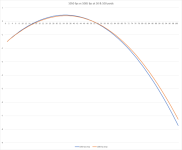
Looks like it'd be somewhere in the 28-36 yard region to me. Looking at actual drop numbers for both shots at a lot of intervals would obviously give a better answer.
Last edited:




















































